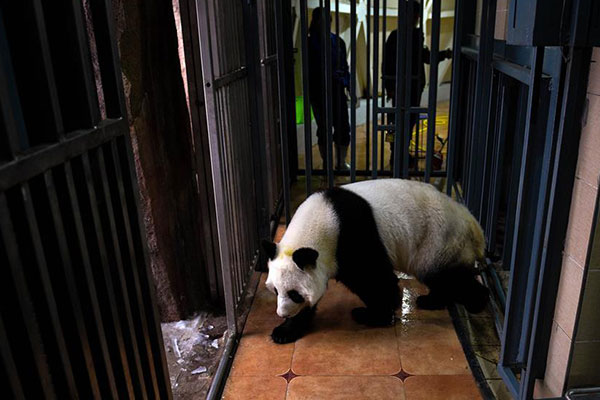
Giant panda Jia Jia takes a rest at a Siberian tiger breeding base in Changchun, Northeast China’s Jilin province, Dec 9, 2015. Two giant pandas Jia Jia and Meng Meng settled into the breeding base in June 2015 and will stay for three years for both public viewing and scientific research, where there is the farthest north a panda has resided for a long period in China, a region usually avoided due to its cold winters, with the species preferring warmer habitats in Southwest China’s Sichuan province. [Photo/Xinhua]
CHANGCHUN — Two giant pandas which were given new homes in Jilin province, remain in good health, the local zoo said.
Jiajia, an 8-year-old male, and Mengmeng, a 7-year-old female, are the first giant pandas to live in a high-altitude habitat in China, after they were moved from Sichuan to Jilin Wild Life Rescue and Breeding Center, in Changchun, capital city of Jilin.
“The pandas have remained in good health since they arrived in July, and they seem to like playing in the snow,” said Wang Haijun, director of the animal management department at the center.
Pandas usually live in rainforests in Sichuan and Shaanxi provinces, they are not known to have lived in the dry cold northern area.
“Pandas have no problem living in temperatures around minus 10 degrees celsius. They looked very excited in the snow and their appetite is also better,” Wang said.
Every day, each panda eats 1.2 kilos of steamed grain buns, 120 grams of carrots, 150 apples and five kilos of bamboo, the latter shipped in from their home province of Sichuan.
“It costs around 50,000 yuan (about $7,800 million) to feed the pandas every month,” Wang said.
The pandas will spend three years in the zoo. Researchers will gather data and carry out breeding tests.

Giant panda Meng Meng plays on a tree at a Siberian tiger breeding base in Changchun, Northeast China’s Jilin province, Dec 9, 2015. Two giant pandas Jia Jia and Meng Meng settled into the breeding base in June 2015 and will stay for three years for both public viewing and scientific research, where there is the farthest north a panda has resided for a long period in China, a region usually avoided due to its cold winters, with the species preferring warmer habitats in Southwest China’s Sichuan province.[Photo/Xinhua]

Giant panda Meng Meng and Jia Jia are seen at a Siberian tiger breeding base in Changchun, Northeast China’s Jilin province, Dec 9, 2015. Two giant pandas Jia Jia and Meng Meng settled into the breeding base in June 2015 and will stay for three years for both public viewing and scientific research, where there is the farthest north a panda has resided for a long period in China, a region usually avoided due to its cold winters, with the species preferring warmer habitats in Southwest China’s Sichuan province.[Photo/Xinhua]

Giant panda Meng Meng tries to climb up a tree at a Siberian tiger breeding base in Changchun, Northeast China’s Jilin province, Dec 9, 2015. Two giant pandas Jia Jia and Meng Meng settled into the breeding base in June 2015 and will stay for three years for both public viewing and scientific research, where there is the farthest north a panda has resided for a long period in China, a region usually avoided due to its cold winters, with the species preferring warmer habitats in Southwest China’s Sichuan province.[Photo/Xinhua]

Giant panda Jia Jia enjoys bamboo shoots at a Siberian tiger breeding base in Changchun, Northeast China’s Jilin province, Dec 9, 2015. Two giant pandas Jia Jia and Meng Meng settled into the breeding base in June 2015 and will stay for three years for both public viewing and scientific research, where there is the farthest north a panda has resided for a long period in China, a region usually avoided due to its cold winters, with the species preferring warmer habitats in Southwest China’s Sichuan province.[Photo/Xinhua]

Giant panda Jia Jia enjoys bamboo shoots at a Siberian tiger breeding base in Changchun, Northeast China’s Jilin province, Dec 9, 2015. Two giant pandas Jia Jia and Meng Meng settled into the breeding base in June 2015 and will stay for three years for both public viewing and scientific research, where there is the farthest north a panda has resided for a long period in China, a region usually avoided due to its cold winters, with the species preferring warmer habitats in Southwest China’s Sichuan province.[Photo/Xinhua]

Giant panda Meng Meng enjoys snow fun at a Siberian tiger breeding base in Changchun, Northeast China’s Jilin province, Dec 9, 2015. Two giant pandas Jia Jia and Meng Meng settled into the breeding base in June 2015 and will stay for three years for both public viewing and scientific research, where there is the farthest north a panda has resided for a long period in China, a region usually avoided due to its cold winters, with the species preferring warmer habitats in Southwest China’s Sichuan province.[Photo/Xinhua]

Giant panda Jia Jia takes a rest at a Siberian tiger breeding base in Changchun, Northeast China’s Jilin province, Dec 9, 2015. Two giant pandas Jia Jia and Meng Meng settled into the breeding base in June 2015 and will stay for three years for both public viewing and scientific research, where there is the farthest north a panda has resided for a long period in China, a region usually avoided due to its cold winters, with the species preferring warmer habitats in Southwest China’s Sichuan province.[Photo/Xinhua]

Giant panda Meng Meng plays on a tree at a Siberian tiger breeding base in Changchun, Northeast China’s Jilin province, Dec 9, 2015. Two giant pandas Jia Jia and Meng Meng settled into the breeding base in June 2015 and will stay for three years for both public viewing and scientific research, where there is the farthest north a panda has resided for a long period in China, a region usually avoided due to its cold winters, with the species preferring warmer habitats in Southwest China’s Sichuan province.[Photo/Xinhua]

Giant panda Meng Meng takes a walk at a Siberian tiger breeding base in Changchun, Northeast China’s Jilin province, Dec 9, 2015. Two giant pandas Jia Jia and Meng Meng settled into the breeding base in June 2015 and will stay for three years for both public viewing and scientific research, where there is the farthest north a panda has resided for a long period in China, a region usually avoided due to its cold winters, with the species preferring warmer habitats in Southwest China’s Sichuan province.[Photo/Xinhua]
